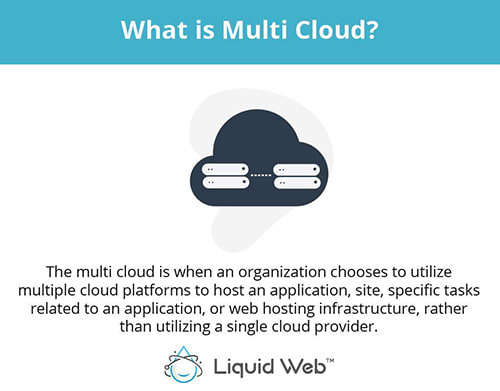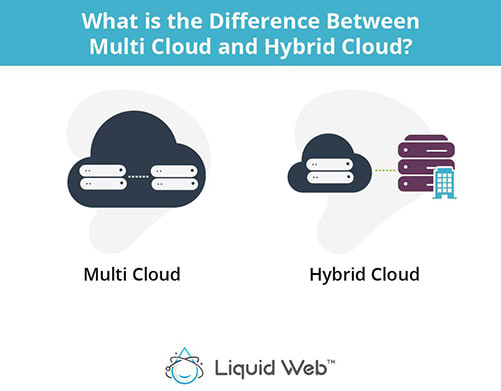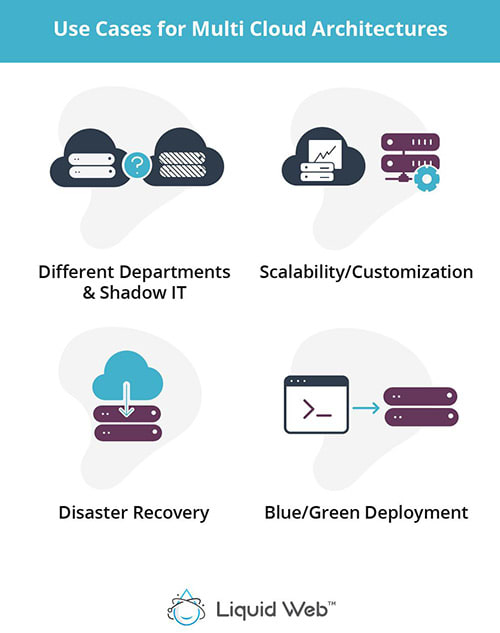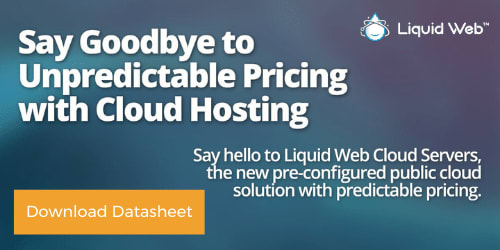
The current state of the web hosting industry is one made up of dozens of companies providing numerous products and services. Often, we see these companies providing overlapping product lines or unique and specialized services that may relate to niche offerings. Web hosting can include plans ranging from shared hosting all the way to cloud services such as public cloud, private cloud, or multi cloud hosting.
Cloud computing and the ability to have your business be hosted online, quickly and easily, is one of the most common and heavily fought over areas in the web hosting industry. Because of the need for businesses to have an ever-present online experience for their customers, it has become useful to spread out systems that make up that online presence across multiple cloud providers.
Known as a “multi cloud” practice, this allows a business to take advantage of the competitive nature of cloud hosting, spread out critical resources across multiple providers, and provide an overall better experience for their customers.

What is Multi Cloud?
Multi cloud is the term that represents using multiple service providers (vendors / companies) or “cloud” platforms for the use and hosting of your application, site, specific tasks related to your application, or web hosting infrastructure rather than utilizing a single cloud provider for everything.
To better grasp the concept of multi cloud and all that it can do, you need to first understand a few terms that are commonly brought up when considering a multi cloud environment.
IaaS (Infrastructure-as-a-Service)
IaaS is a cloud computing service where the consumer receives the use of a virtual machine (VM). The IaaS provider specifies the amount of hardware performance/capacity to allocate to the VM, starts the VM, and boots it with the chosen operating system (OS).
PaaS (Platform-as-a-Service)
PaaS is a cloud computing service that provides a “platform,” or a specific environment that could include applications and tools, focused on development and creation. This allows customers to develop, run, and manage applications without the complexity of maintaining and administering the underlying infrastructure.
SaaS (Software-as-a-Service)
SaaS is a cloud computing model where software is licensed for use on a subscription model and centrally hosted, but the underlying services and infrastructure running the software are hidden. Example of SaaS would be Google Apps, Slack, and Dropbox.
Virtual Machine (VM)
A virtual machine is software that provides the same functionality as a server; however, it utilizes shared physical resources with potentially other virtual machines on the same physical machine.
Subscription Model
A subscription model is where clients pay a recurring fee for use or access to a product. Halting payment either reduces access or completely removes the product from use.
Cloudification
Cloudification is the conversion and/or migration of data and application programs in order to make use of cloud computing.
Multi Cloud Relocation
Multi cloud relocation is moving an on-premise application to be stored/deployed on a cloud platform and use cloud services to enhance capabilities.
Multi Cloud Refactoring
Multi cloud refactoring is the redesigning of an application to be architectured for full use on multiple cloud platforms.
Multi Cloud Rebinding
Multi cloud rebinding is the redesigning of an application to be architectured for partial use/deployment on multiple cloud platforms. This enables the application to continue functioning in the primary location/deployment with an alternative deployment available for failure scenarios with the original environment.
Why Should You Consider a Multi Cloud Infrastructure?
The overall idea behind a multi cloud environment is that no single hosting provider can fill every niche or provide a solution to all the problems a business may encounter with their online presence. Different hosting companies have different specializations as well as varying degrees of support for the products they offer.
By altering your application to use cloud computing, which is known as cloudification, you are able to utilize these different companies and take advantage of their specializations so your business can receive the benefits of each provider for the specific parts of your application or business.
A multi cloud offering is not only utilizing different providers. Since not all hosting providers provide locations on every continent or in every country, it can often be beneficial to alter your application so it can be used in multiple locations across multiple providers, known as multi cloud refactoring. This can allow you to host multiple copies of your application in different geographical locations. Users from around the globe will have faster access due to being closer to the application source, and you will have a degree of redundancy in the event of failure.
An additional benefit of having your data copied and located in multiple countries is allowing for easier compliance with regards to data storage laws in various countries, such as GDPR in Europe.

What is the Difference Between Multi Cloud and Hybrid Cloud?
Often the term “multi cloud” and “hybrid-cloud” are used interchangeably. These are, from a technical stand-point, two different ideas:
Multi Cloud is the idea of utilizing multiple cloud providers to provide the hosting infrastructure for your entire application or business. In this setup, you utilize public and private WAN (wide area network) connections to provide connectivity to the various cloud service implementations. Your entire application is hosted in the multi cloud to gain benefits in cost savings, particular cloud features, or geographical advantages.
Hybrid cloud is a mixture of cloud provider hosting and local private cloud hosting. In this setup, you utilize your own infrastructure in your own data center but connect it up to a cloud provider for particular benefits such as geo-redundancy, a managed feature-set, or even price. Once again, you use a combination of public and private WAN connections to allow the private cloud infrastructure and the public cloud infrastructure to effectively communicate.
What are the Benefits and Drawbacks of Multi Cloud?
A multi cloud environment comes with many challenges and benefits. Here are the top 5 benefits and drawbacks for choosing a multi cloud environment:
| Benefits of Multi Cloud | Drawbacks of Multi Cloud |
|---|---|
| Reduce vendor lock-in/reliance | Management of multiple providers increases operational complexity |
| Focus on services needed (specific offering, SLA, etc.) | Potential security concerns with multiple attack vectors across multiple providers |
| Better application availability/uptime with multiple providers | Need for more specialized and trained personnel understanding multi cloud architectures |
| Cost savings by offloading operational expenditures to providers | Potential for network latency issues and bandwidth consumption |
| Ease of satisfying regulatory requirements for data storage compliance | Arrive to multi cloud by accident creating a Shadow IT [1] scenario |
[1] – Shadow IT is the use of IT-related hardware or software by a department or individual without the knowledge of the IT or security group within the organization. It can encompass cloud services, software, and hardware.

What are the Use Cases for Multi Cloud Architectures?
Now, let’s examine a few potential use cases for various multi cloud architectures in case you’re still unsure how you might take advantage of this type of environment.
Different Departments and Shadow IT
In this example, a company operates a WordPress blog to reach out to potential and existing clients. They need great uptime and ease-of-use. The marketing team, while understanding the technical concepts of WordPress, may not necessarily have the time or expertise to sufficiently handle the administration of a WordPress install and the upkeep. As a result, the marketing team wants to utilize a provider that offers a managed WordPress service that takes care of everything behind the scenes and leaves the content creation up to them.
Behind the scenes, the development team needs to be able to handle workloads for their application in an automated fashion. They want a web host that offers the tools to provide elastic and automatic scaling of services and servers as visitor demands increase or decrease. An issue arises if the two departments opt to use different cloud providers without communicating with each other. This creates what is known as a “Shadow IT” scenario, where services or providers are used without the knowledge of other members of your team. The added complexity of having multiple providers creates a burden on all involved when having to diagnose issues or train new individuals since the usage of multiple providers may not be known or even condoned.
Scalability/Customization
Consider another scenario in which you have different components within your application that have different requirements. Within your web server, you need scalability on short notice. You may want automated components to utilize the best price from a provider, or to simply increase or decrease the size of your web nodes as traffic spikes. Your front end will need a provider with a strong API and cloud server presence that allows for automated changes.
The backend for your application has some very specific customized needs that differ. Perhaps it needs raw processing power and complex or unique hardware requirements. Often, cloud providers lock you in to a particular template or specific hardware (you may even be sharing the hardware with other users), but dedicated servers allow complete flexibility with the hardware used to build them. This customization can be obtained from one provider, and using private WAN connections provides a secure path to your cloud-based servers at another provider, thus giving the scalability and power needed.
Disaster Recovery
An additional benefit to utilizing multiple cloud providers is the ability to have a “hot spare” or backup set of infrastructure immediately available for any type of disaster recovery scenario.
Having duplicate sets of infrastructure in different geographical locations with different providers while synchronizing data between the two creates an ideal setup for handling any type of potential outage.
Blue/Green Deployment
When preparing changes for your production environment, it’s often helpful to have a staging environment that mimics production that you can switch traffic to when ready for changes to be pushed out. This model, referred to as “blue/green”, is another benefit of multi cloud. While even using the same provider, you have the ability to quickly direct traffic to one set of infrastructure and then move it back if issues arise. This further assists with minimizing downtime, and by directing limited amounts of traffic to a given version of the application, you can even limit user exposure.
Move to Multi Cloud With Cloud Servers at Liquid Web
As you continue down the path of growing your company, building out your application, and acquiring customers, you will find your hosting needs change. The use cases for multi cloud environments are evolving and workloads are adapting to the technologies that allow for a company or application to take advantage of multi cloud architectures.
Businesses need to calculate the value that a multi cloud tenancy could provide while simultaneously evaluating the cost to implement. The choice to move to a multi cloud infrastructure is one that should be discussed with the various people or teams that make up your company and the providers you wish to work with. However, there are clear and growing benefits to doing so that could make your hosting experience and online presence move to the next level.
Say Goodbye to Unpredictable Pricing and Hello to Liquid Web Cloud Servers
[ad_2]
Source link







